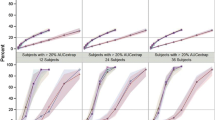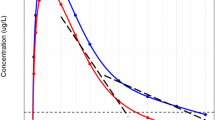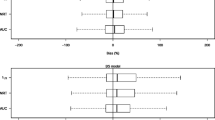Abstract
It is not uncommon in pharmacokinetic (PK) studies that some concentrations are censored by the bioanalytical laboratory and reported qualitatively as below the lower limit of quantification (LLOQ). Censoring concentrations below the quantification limit (BQL) has been shown to adversely affect bias and precision of parameter estimates; however, its impact on structural model decision has not been studied. The current simulation study investigated the impact of the percentage of data censored as BQL on the PK structural model decision; evaluated the effect of different coefficient of variation (CV) values to define the LLOQ; and tested the maximum conditional likelihood estimation method in NONMEM VI (YLO). Using a one-compartment intravenous model, data were simulated with 10–50% BQL censoring, while maintaining a 20% CV at LLOQ. In another set of experiments, the LLOQ was chosen to attain CVs of 10, 20, 50 and 100%. Parameters were estimated with both one- and two-compartment models using NONMEM. A type I error was defined as a significantly lower objective function value for the two-compartment model compared to the one-compartment model using the standard likelihood ratio test at α = 0.05 and α = 0.01. The type I error rate substantially increased to as high as 96% as the median of percent censored data increased at both the 5% and 1% alpha levels. Restricting the CV to 10% caused a higher type I error rate compared to the 20% CV, while the error rate was reduced to the nominal value as the CV increased to 100%. The YLO option prevented the type I error rate from being elevated. This simulation study has shown that the practice of assigning a LLOQ during analytical methods development, although well intentioned, can lead to incorrect decisions regarding the structure of the pharmacokinetic model. The standard operating procedures in analytical laboratories should be adjusted to provide a quantitative value for all samples assayed in the drug development setting where sophisticated modeling may occur. However, the current level of precision may need to be maintained when laboratory results are to be used for direct patient care in a clinical setting. Finally, the YLO option should be considered when more than 10% of data are censored as BQL.
Similar content being viewed by others
References
FDA guidance for industry bioanalytical method validation. Available from http://www.fda.gov/cder/guidance/4252fnl.pdf Accessed on may 2001
Shah VP, Midha KK, Findlay JW, Hill HM, Hulse JD, McGilveray IJ, McKay G, Miller KJ, Patnaik RN, Powell ML, Tonelli A, Viswanathan CT and Yacobi A (2000). Bioanalytical method validation—a revisit with a decade of progress. Pharm Res 17(12): 1551–1557
Hing JP, Woolfrey SG, Greenslade D and Wright PM (2001). Analysis of toxicokinetic data using NONMEM: impact of quantification limit and replacement strategies for censored data. J Pharmacokinet Pharmacodyn 28(5): 465–479
Beal SL (2001). Ways to fit a PK model with some data below the quantification limit. J Pharmacokinet Pharmacodyn 28(5): 481–504
Duval V and Karlsson MO (2002). Impact of omission or replacement of data below the limit of quantification on parameter estimates in a two-compartment model. Pharm Res 19(12): 1835–1840
Beal SL (2005). Conditioning on certain random events associated with statistical variability in PK/PD. J Pharmacokinet Pharmacodyn 32(2): 213–243
Fletcher CV, Anderson PL, Kakuda TN, Schacker TW, Henry K, Gross CR and Brundage RC (2002). Concentration-controlled compared with conventional antiretroviral therapy for HIV infection. AIDS 16(4): 551–560
Kakuda TN, Page LM, Anderson PL, Henry K, Schacker TW, Rhame FS, Acosta EP, Brundage RC and Fletcher CV (2001). Pharmacological basis for concentration-controlled therapy with zidovudine, lamivudine, and indinavir. Antimicrob Agents Chemother 45(1): 236–242
Zhou XJ, Sheiner LB, D’Aquila RT, Hughes MD, Hirsch MS, Fischl MA, Johnson VA, Myers M and Sommadossi JP (1999). Population pharmacokinetics of nevirapine, zidovudine, and didanosine in human immunodeficiency virus-infected patients. The National Institute of Allergy and Infectious Diseases AIDS Clinical Trials Group Protocol 241 Investigators. Antimicrob Agents Chemother 43(1): 121–128
Mirochnick M, Capparelli E and Connor J (1999). Pharmacokinetics of zidovudine in infants: a population analysis across studies. Clin Pharmacol Ther 66(1): 16–24
Capparelli EV, Englund JA, Connor JD, Spector SA, McKinney RE, Palumbo P and Baker CJ (2003). Population pharmacokinetics and pharmacodynamics of zidovudine in HIV-infected infants and children. J Clin Pharmacol 43(2): 133–140
RETROVIR® prescribing information. Available from http://us.gsk.com/products/assets/us_retrovir.pdf Accessed on Nov 2006
Beal SL, Sheiner LB, Boeckmann AJ (eds) (1989–2006) NONMEM users guides. Icon development solutions. Ellicott City
Stram DO and Lee JW (1994). Variance components testing in the longitudinal mixed effects model. Biometrics 50(4): 1171–1177
Sheiner LB and Beal SL (1981). Some suggestions for measuring predictive performance. J Pharmacokinet Biopharm 9(4): 503–512
ICH harmonized tripartitie guideline: validation of analytical procedures Q2(R1). Available from http://www.ich.org/LOB/media/MEDIA417.pdf
Fitzmaurice GM, Laird NM, Ware JH (2004) Applied longitudinal analysis. Wiley
Author information
Authors and Affiliations
Corresponding author
Rights and permissions
About this article
Cite this article
Byon, W., Fletcher, C.V. & Brundage, R.C. Impact of censoring data below an arbitrary quantification limit on structural model misspecification. J Pharmacokinet Pharmacodyn 35, 101–116 (2008). https://doi.org/10.1007/s10928-007-9078-9
Received:
Accepted:
Published:
Issue Date:
DOI: https://doi.org/10.1007/s10928-007-9078-9




